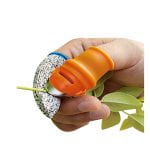Read Part I of this series, here: Create a cut flower garden: Planning
When choosing a location for a cut flower garden, look for an area where you’ll be able to pass comfortably, even when carrying a basket or bucket of flowers. Consider a border against a south facing wall of your home, a designated garden patch, or even adding clumps or rows of flowers to an existing vegetable garden.
Cut flowers need well-drained soil that’s rich in organic matter so that it will hold water for your blossoms. Plan to work in 2-3 inches of compost or well-rotted leaves to your soil. Add a dose of a balanced, slow-acting granular organic fertilizer at the beginning of the season. If you notice blooms fading later on, fertilize them during the season as well.
Transplant your seedlings after the last spring frost (May 15-31 for Zone 4). Be sure to check the heights of your mature flowers and plant the tall ones to the north of the shorter flowers to prevent shading. For direct seeded plants, sow a few extra seeds – we have a short growing season and don’t have time to reseed if they don’t germinate the first time. It’s better to thin them later than to start over. To control weeds and retain soil moisture, add a 2-3” layer of mulch around the plants, staying at least an inch away from the plant on all sides. Read more Create a cut flower garden Part II: Planting








